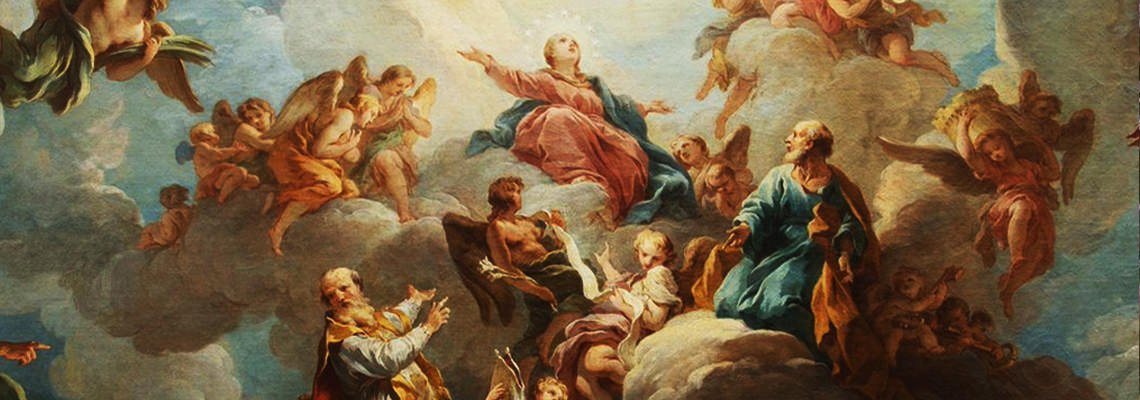Good morning good people,
May the Lord give you peace and health in the Holy Spirit.
It is 15th August 2021. We celebrate the solemnity of the Assumption of the Blessed Virgin Mary.
We reflect on Revelation 11:19; 12:1-6, 10; 1 Cor 15:20-26 and the Gospel of Luke 1:39-56.
A teacher asked the children in her Sunday School class, “If I sold my house and my car, had a big garage sale, and give all the money to the church, would I get into heaven?” “No!” The children all answered. “If I cleaned the church every day, mowed the yard, and kept everything neat and tidy, would I then get into heaven?” Again, the answer was “NO!” “Well,” she continued, “then how can I get into heaven? In the back of the room, a five-year-old boy shouted, “You got to be dead!”
The assumption of BVM is the dogma of the church. As a dogma, the Assumption is a required belief of all Catholics. Anyone who publicly dissents from the dogma, Pope Pius declared, “has fallen away completely from the divine and Catholic Faith.”
When, in 1950, Pope Pius XII solemnly defined the dogma of the Assumption, he said “the Immaculate Mother of God, the ever-Virgin Mary, having completed the course of her earthly life, was assumed body and soul into heavenly glory.” That seems to leave open the question of whether Mary died first.
Pope Pius XII, in Munificentissimus Deus, states: “this feast shows, not only that the dead body of the Blessed Virgin Mary remained incorrupt, but that she gained a triumph out of death, her heavenly glorification after the example of her only begotten Son, Jesus Christ.”
Some theologians feel that, since death is a consequence of sin, Mary would not have had to die. But others say that, since Jesus himself chose to die, wouldn’t it be fitting for his mother to have shared the same fate?
On the question of where Mary spent her final years on earth, there are two strong historical traditions. One is that, following the ascension of Jesus, Mary returned with the apostles to Jerusalem and lived there for the remainder of her earthly years.
St. Epiphanius of Salamis, bishop of Salamis belonged 4th century teaches us: “The holy virgin may have died and been buried – her falling asleep was with honour, her death in purity, her crown in virginity. Or she may have been put to death – as the scripture says, ‘And a sword shall pierce through her soul’ – her fame is among the martyrs and her holy body, by which light rose on the world, [rests] amid blessings. Or she may have remained alive, for God is not incapable of doing whatever he wills. No one knows her end.”
The Virgin indeed assumed into the Heavenly Jerusalem, “continues her work as our advocate and minister of salvation besides the King of glory” (Preface, Mass of Our Lady of Mercy). Mary helps in understanding that only in her Divine Son can the full sense and value of our life be found. In this way, “hope for the eschatological goal” towards which we are “journey[ing] as members of the pilgrim People of God in history” is nourished in us (Apostolic Letter Rosarium Virginis Mariae, n. 23). In Her, we are able to foresee the “destiny of glory” that awaits them.
Our Lady’s Assumption reminds us that our true homeland is heaven, and she offers us her motherly help to prepare for the definitive meeting with Christ at the end of our earthly pilgrimage.
It is time up to look at our beloved Mother Mary, Star of Hope, who illumines us on our earthly journey and follow the example of the Saints who turned to her in every circumstance.
St John Mary Vianney spoke to Our Lady with devotion and, at the same time, with trust and spontaneity. “The Blessed Virgin is immaculate and adorned with all the virtues that make her so beautiful and pleasing to the Blessed Trinity. The heart of this good Mother is nothing but love and mercy, all she wants is to see us happy. To be heard, it suffices to address oneself to her. The Blessed Virgin is a beautiful Creature who never displeased the good Lord.” (B. Nodet, Il pensiero e l’anima del Curato d’Ars, Turin 1967, p. 303)., p. 307).
The first reading speaks of a struggle between the woman and the dragon, between good and evil. St. John representing us with the struggle of man and woman with evil in the garden of Eden. They could not overpower the evil and the evil defeated them. By God’s salvific plan, Jesus, the new Adam, and Mary, the new Eve triumphed over the enemy once and for all, and this is the joy of this day! Death in all forms and evil in its totality put to rest by the sacrifice of Jesus.
In the Gospel of St Luke, we read that “in those days Mary arose and went with haste into the hill country, to a city of Judah” (Lk 1:39). Mary hastened to see her kinswoman, Elizabeth. Today we contemplate her going up towards God’s Mountain and entering the heavenly Jerusalem, “clothed with the sun, with the moon under her feet, and on her head a crown of twelve stars” (Rev 12:1).
No one has loved God like Mother Mary and so God honoured her with the incorruptibility of body and soul. Some of us are already dead spiritually. There is an empty space in each one of us, nothing or no one can fill that space except God alone.
“All generations will call me blessed” (Lk 1:48). The Assumption of Mary in Heaven, in body and soul, is a divine privilege given to her because of her particular union with Jesus. It is a corporal and spiritual union, which began with the Annunciation and matured throughout Her life by Her special and unique participation in the mystery of Jesus. Mary accompanied Jesus her Son and followed Him as His first disciple. It is because of her participation; God offered her full participation in the resurrection of Jesus. The body of the Blessed Mother was preserved from corruption, like that of the Son. Teacher: How was your paper? Student: wonderful, but I didn’t know d past tense of “think”. I thought and thought and thought then finally wrote “thunk.”
This Feast, then, speaks of our future. It tells us that we too shall be beside Jesus in God’s joy and invites us to take heart, to believe that the power of Christ’s Resurrection can also work in us, making us men and women who seek every day to live as risen ones, bringing the light of goodness into the darkness of the evil in the world.
Today the Church invites us to contemplate this mystery: God desires to save the entire person, with body and soul.
The Assumption of Mary offers the future glory that waits for every one of us who participate in the mission and vision of Jesus. This — the “resurrection of the flesh” — is a specific element of Christian revelation, a cornerstone of our faith.
the Assumption of Mary reveals and confirms the unity of the human person and reminds us that we are called to serve and glorify God with our whole being, soul, and body. To serve God with the body alone would be the action of slaves; to serve him with the soul alone would be counter to our human nature. Around the year 220, a great Father of the Church, Saint Irenaeus, stated that “the glory of God is a living man, and the life of man consists in beholding God”
We must therefore fully dedicate ourselves to accomplishing the exhortation of the Apostle Paul: “glorify God in your body” (1 Cor 6:20), and we shall forever glorify him in heaven.
Let us pray that Mary, through her maternal intercession, may help us live our daily journey in the earnest hope of being able to reach her one day, with all the Saints and our loved ones, all in heaven. May our Mother Mary intercede for India as it celebrates its 75th Independence Day celebration. God bless you all.


